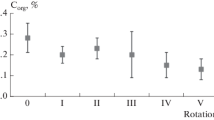Summary
Perennial ryegrass and red clover were grown in the glasshouse on six soils from different geochemical environments in Co. Limerick, Somerset, and Staffordshire, to study the influence of various soil additives on the uptake of molybdenum and selenium by the plants.
Ammonium sulphate most successfully and consistently depressed the uptake of molybdenum by perennial ryegrass and red clover. It seems that the decrease in the molybdenum content of the herbage is caused largely by the ammonium ion. Uptake may also be decreased by dilution due to the greater amount of dry matter produced, by acidification of the soil and by the effect of the sulphate ion. The importance of these contributing factors differs from one environment to another.
Ammonium sulphate and elemental sulphur markedly decreased the selenium content of herbage, the ammonium salt giving the most persistent effect. Both the ammonium and the sulphate ions seem to be involved.
On most of the soils tested ammonium sulphate decreased molybdenum contents of herbage from potentially toxic to marginal or normal amounts. Calcium orthophosphate and potassium sulphate sometimes increased molybdenum and selenium uptake and the use of these fertilizers on toxic soils should be considered with caution. Liming consistently increased herbage molybdenum content.
Similar content being viewed by others
References
Attoe, O. J. and Olson, R. A., Factors affecting rate of oxidation in soils of elemental sulphur and that added in rock phosphate-sulphate fusions. Soil Sci.101, 317–325 (1966).
Barshad, I., Factors affecting the molybdenum content of pasture plants. II. Effect of soluble phosphates, available nitrogen, and soluble sulphates. Soil Sci.71, 387–397 (1951).
Dye, W. B. and O'Harra, J. L., Molybdenosis. Agricultural Experimental Station. Max C. Fleischmann College of Agriculture, University of Nevada Bull.208, (1959).
Finch, T. F. and Ryan, P., Soils of County Limerick National Soil survey of Ireland, Soil Survey Bull. No.16, p. 139 (1966).
Fleming, G. A., Trace elements in plants with particular reference to pasture species Outlook on Agr.4, 270 (1965).
Fleming, G. A., Personal communication (1966).
Fleming, G. A., Cobalt, selenium and molybdenum in Irish soils. Welsh Soils Discussion Group Rept.9, 41–56 (1968).
Fleming, G. A. and Walsh, T., Selenium occurrence in certain Irish soils and its toxic effects on animals. Proc. Roy. Irish Acad. Sect. B,58, 151–166 (1957).
Hurd-Karrer, A. M., Selenium injury to wheat plants and its inhibition by sulphur. J. Agr. Research49, 343–357 (1934).
Hurd-Karrer, A. M., Selenium absorption by crop plants as related to their sulphur requirements. J. Agr. Research54, 601–608 (1937).
Le Riche, H. H., Molybdenum in the lower lias of England and Wales in relation to the incidence of teart. J. Soil Sci.10, 133–136 (1959).
Lewis. A. H., The teart pastures of Somerset. II Relation between soil and teartness. J. Agr. Sci.33, 52–57 (1943).
Lewis, A. H., The teart pastures of Somerset. III Reducing the teartness of pasture herbage. J. Agr. Sci.33, 58–63 (1943).
Mitchell, R. L., Reith, J. W. S., and Johnston, I. M., Trace element uptake in relation to soil content. J. Sci. Food Agr.8, 551 (1963).
Rosenfeld, I. and Beath, O. A., Selenium-Geobotany, Biochemistry, Toxicity and Nutrition. Academic Press, New York and London (1964).
Stanton, R. E., Rapid Methods of Trace Analysis for Geochemical Applications. Edward Arnold (Publ.) Ltd., London (1966).
Stanton, R. E. and Hardwick, A. J., The colorimetric determination of molybdenum in soils and sediments by zinc dithiol. Analyst92, 387–390 (1967).
Stout, P. R., Meagher, W. R., Pearson, G. A., and Johnson, C. M., Molybdenum nutrition of crop plants. Plant and Soil3, 51–87 (1951).
Thomson, I., Regional Geochemical Reconnaissance of Black Shale Facies with Particular Reference to the Incidence of Trace Element Disorders in Crops and Animals. Ph. D. Thesis, University of London. (In preparation).
Thornton, I., Moon, R. N. B., and Webb, J. S., Geochemical reconnaissance of the lower lias. Nature221, 457–459 (1969).
Walsh, T., Neenan, M., and O'Moore, L. B., High molybdenum levels in herbage on acid soils. Nature171, 1120 (1953).
Webb, J. S., Geochemistry and life. New Scientist23, 504–507 (1964).
Webb, J. S., and Atkinson, W. A., Regional geochemical reconnaissance applied to some agricultural problems in Co. Limerick, Eire. Nature208, 1056–1059 (1965).
Webb, J. S., Thornton, I., and Fletcher, W. K., Geochemical reconnaissance and hypocuprosis. Nature217, 1010–1012 (1968).
Author information
Authors and Affiliations
Rights and permissions
About this article
Cite this article
Williams, C., Thornton, I. The effect of soil additives on the uptake of molybdenum and selenium from soils from different environments. Plant Soil 36, 395–406 (1972). https://doi.org/10.1007/BF01373493
Received:
Revised:
Issue Date:
DOI: https://doi.org/10.1007/BF01373493




